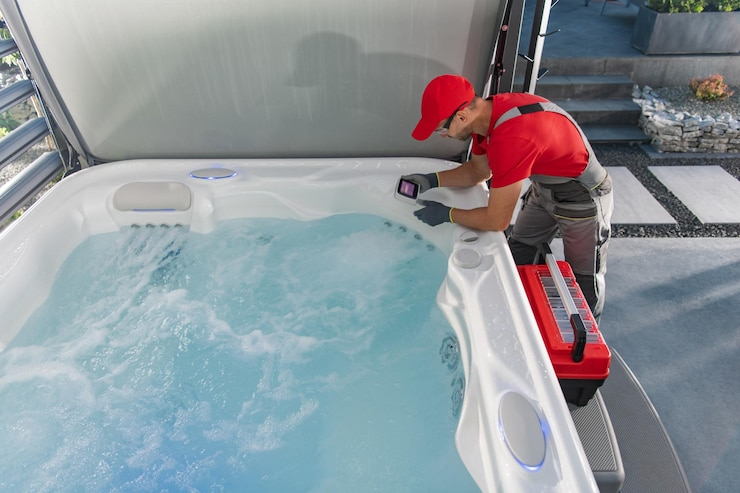Stop Wasting Money: The Ultimate Guide to Pool Leak Detection (And How to Fix It Fast)
- Vanshika Thareja

- Nov 3
- 6 min read

Why Pool Leaks Are Silent Profit Killers
Is your pool secretly draining your wallet?
While it may look calm and pristine, a leaking pool can cost you thousands in water bills, structural damage, and repairs — if you don’t catch it early.
Pool leak detection isn’t just about saving water; it’s about protecting your investment, avoiding long-term damage, and ensuring your pool stays swim-ready all season long.
In this comprehensive guide, we’ll reveal:
🔎 How to detect a pool leak fast
💸 Common causes of leaks (and how much they cost you)
🛠️ DIY tips vs. when to call a pro
📊 The proven step-by-step process to find and fix any leak
📈 How early detection boosts property value and reduces liabilities
Let’s dive in (pun intended).
Section 1: The Cost of Ignoring a Pool Leak
💧 “It’s Just Evaporation,” Right? Think Again.
Many pool owners confuse leaks with evaporation. But here's a staggering fact:
🌡️ A typical pool loses 1/4 inch of water daily from evaporation. A leak adds 2x to 10x more loss.
That means:
1/4" daily = ~150 gallons/week (normal)
1"+ daily? You’re losing over 600+ gallons a week — or $2,500+ annually.
Key takeaway: The faster you detect the leak, the less money you burn.
Section 2: 7 Warning Signs Your Pool Has a Leak
How do you know if your pool is leaking?
Here are the top 7 tell-tale signs:
Unusual Water Loss
If you’re refilling your pool more than once a week, that’s a red flag.
Spike in Water Bills
Compare bills from last year. A hidden leak can increase costs by 20–30%.
Cracks in the Pool Deck or Shell
Water escapes through structural damage, worsening over time.
Air in the Pump or Bubbling Return Jets
Indicates suction-side leaks pulling air in.
Soggy Spots or Mushy Grass
Wet areas around the pool signal underground pipe leaks.
Algae Blooms or Chemical Imbalance
A leaking pool loses treated water, disrupting balance and inviting bacteria.
Drop in Pool Level Even When Not in Use
If no swimmers are in, but water is still disappearing — something’s wrong.
Pro Tip: Use the bucket test (covered below) to confirm evaporation vs. leak.
Section 3: Top 5 Causes of Pool Leaks (And What To Do About Them)
1. Plumbing Leaks
Location: Underground pipes, return lines, or main drains.
Fix: Pressure testing and pipe repair or rerouting.
Cost: $500–$3,000 depending on access and severity.
2. Cracks in the Pool Shell
Location: Gunite, vinyl, or fiberglass surfaces.
Fix: Epoxy injection or resurfacing.
Cost: $150–$5,000 depending on repair size.
3. Leaky Pool Lights or Skimmers
Location: Around light niches and skimmer throats.
Fix: Sealant application or gasket replacement.
Cost: $100–$800
4. Faulty Equipment
Location: Pump seals, filters, chlorinators, valves.
Fix: Replace damaged components or tighten fittings.
Cost: $50–$1,000
5. Loose Fittings or Tile Damage
Location: Around returns, jets, or tile line.
Fix: Re-caulking, tile replacement, or regrouting.
Cost: $150–$1,500
Important: Leaks never fix themselves. Waiting only makes it more expensive.
Section 4: The 5-Minute Bucket Test (Your Leak Detection Superpower)
The bucket test is a simple, foolproof way to tell if you have a leak or just evaporation.
How to Do It:
Fill a 5-gallon bucket with pool water.
Place it on a pool step, marking the water level inside and outside.
Leave it for 24 hours (pump off).
Compare the levels.
🔍 If the pool water drops more than the bucket water, you have a leak.
Time-saving. Money-saving. Worry-saving.
Section 5: 4 DIY Leak Detection Methods That Work
1. Dye Test
Use red food coloring or leak detection dye near suspected cracks.
Watch if the dye is pulled into the crack — a leak confirmed.
2. Visual Inspection
Look for tile damage, damp areas, or hairline cracks.
3. Check the Equipment Pad
Listen for hissing, dripping, or see wet spots.
4. Monitor Water Levels
Mark the waterline each night for 3 days and track the loss.
🧠 Tip: Use pool apps or a digital water leveler for accurate tracking.
Section 6: When to Call a Professional (And What They Actually Do)
Sometimes, DIY just isn’t enough. If the leak persists, it’s time to call a certified leak detection specialist.
What Pros Use:
Pressure Testing
Ultrasonic Sound Detection
Dye Testing
Infrared Scanning
Subsurface Leak Mic Detection
What to Expect:
Inspection Cost: $300–$600
Repair Estimate: Based on severity and access
Timeframe: Most leaks can be located within 1–2 hours
✅ Bonus: Many companies waive inspection fees if you proceed with repairs.
Section 7: How to Prevent Future Pool Leaks
💼 6 Must-Follow Maintenance Habits:
Schedule annual inspections
Monitor chemical levels weekly
Inspect pump and filter seals monthly
Seal minor cracks immediately
Upgrade outdated equipment
Avoid over-chlorination or water imbalance
💡 A $50 fix today can prevent a $5,000 disaster later.
Section 8: The ROI of Early Leak Detection
Not only does leak detection save you money, but it also boosts property value and buyer trust.
📈 Benefits:
Higher resale value
Reduced liability risk
Lower maintenance costs
Fewer insurance claims
Stat to Know:
Homes with properly maintained pools sell 23% faster and for 6–8% more on average.
Don’t let hidden damage destroy your pool’s potential.
Section 9: Common Myths About Pool Leaks (Debunked)
🚫 Myth 1: “It’s just evaporation”✅ Truth: More than ½ inch per day is likely a leak.
🚫 Myth 2: “Vinyl pools don’t leak easily”✅ Truth: Vinyl liners are prone to punctures and seam tears.
🚫 Myth 3: “If I can’t see it, it’s not a problem”✅ Truth: Most serious leaks are underground or behind walls.
Conclusion: Take Action Today — Your Pool’s Health Depends On It
Here’s the bottom line: Pool leaks are not just an inconvenience — they’re a financial sinkhole.
But armed with this guide, you now know:
How to detect leaks
Where to look
What to do next
🛑 Stop guessing. 🛠️ Start testing.
Detect early. Fix fast. Save thousands.
👉 Act now before the damage worsens. Whether you’re a homeowner, pool service pro, or property manager — taking proactive steps today protects your investment tomorrow.
🔍 Frequently Asked Questions (FAQs) About Pool Leak Detection
1. How do I find a leak in my inground pool without draining it?
You can use tools like dye testers, electronic leak detectors, and acoustic listening devices to locate leaks underwater. Professionals often detect leaks without ever draining your pool by using scuba gear and specialized cameras.
2. Can a leaking pool cause sinkholes or structural damage?
Yes. A persistent underground leak can erode soil, leading to voids beneath the pool shell or deck. In rare cases, this may contribute to sinking, cracking, or even localized sinkholes, especially in areas with soft or sandy soil.
3. How long does it take for a pool leak to become serious?
Some leaks can cause significant damage within weeks, especially if they affect plumbing or the foundation. Minor leaks can evolve into expensive structural problems in as little as 30–60 days if left untreated.
4. Is a vinyl liner pool more prone to leaks than a concrete pool?
Yes. Vinyl liners are more susceptible to tears, seam separations, and punctures, especially from sharp objects or pets. Concrete (gunite) pools are more durable but may crack over time if not properly maintained.
5. Can pool leaks occur during winter when the pool is closed?
Absolutely. Leaks can happen during off-season months due to ground shifting, freeze-thaw cycles, or cracked pipes. Many leaks go unnoticed until spring opening, leading to unexpected damage.
6. Will insurance cover the cost of pool leak detection or repair?
It depends on your policy. Some homeowners insurance may cover leaks caused by sudden, accidental damage — but gradual wear and tear or poor maintenance are often excluded. Always check your coverage details.
7. Are pool leak detection companies worth the cost?
Yes, especially when DIY methods fail. Professionals use advanced diagnostics and can often pinpoint leaks within an hour, saving you money in long-term water loss and unnecessary guesswork.
8. Can I use food coloring instead of leak detection dye?
Yes. Red or blue food coloring can work in a pinch for minor leak detection in still water, like near suspected cracks or around the skimmer. However, commercial dye is more visible and precise.
9. What’s the difference between a structural leak and a plumbing leak?
Structural leaks occur in the pool shell, liner, or tile area.
Plumbing leaks happen in pipes, returns, drains, or the filtration system.Each type requires different detection methods and repair strategies.
10. How often should I inspect my pool for leaks?
Conduct a basic leak inspection at the start and end of each swimming season. For year-round pools, check quarterly or whenever you notice unusual water loss or chemical imbalance.



Comments